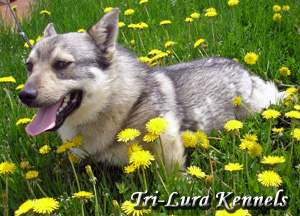
Swedish Vallhund
Group: Herding Dogs
Origin: Sweden
Height: 12 to 14 inches (30-36 cm)
Weight: 20 to 30 lbs (9-13.5 kg)
Also Known As:
– Västgötaspets, Vikingarnas Hund, or Viking Dog

CLICK HERE to View Breeder Listings
Breed Profile
The Swedish Vallhund, also known as the Västgötaspets, Vikingarnas Hund or Viking Dog, is native to Sweden and dates back more than 1000 years to the days of the Vikings. The breed has long been treasured in his homeland for his cattle-herding ability, strength and stamina. He was bred to work as a cattle and sheep herder, herding low to the ground by rounding up and nipping at the hocks. He is also an accomplished ratter and watchdog.
He is intelligent, alert, energetic, self-confident, courageous, loyal, and makes an excellent family companion. The SV is easily trained as he is eager to please. The breed is known to be friendly, healthy and hardy. Always alert and watchful, he will stand his ground but is not aggressive.
The Swedish Vallhund is a versatile family companion as well as a working dog. In addition to herding, he also excels in the show ring, obedience trials and agility.
His coat is of medium length, harsh to the touch, close and tight fitting. He may be steel-grey, greyish brown, greyish yellow or reddish brown. He should also have lighter markings on the shoulders which are called “harness markings”.
The breed is commonly seen in Sweden, Britain, Finland, Norway and Australia and is gaining popularity in North America. In North America, Swedish Vallhunds are recognized by the Canadian Kennel Club, the United Kennel Club and other registries. At this time, the Swedish Vallhund Club of America is working to gain American Kennel Club recognition of the breed.
Health Issues
The Swedish Vallhund is known to be a healthy breed with relatively few genetic disorders. However, some disorders have been seen, including: Hip Dysplasia, Patellar Luxation, Cleft Palate, and Eye Diseases.
If you are considering the adoption of a Swedish Vallhund puppy, or any breed, it is very important to be selective in choosing a responsible and reputable breeder. Ensure that the prospective puppy’s parents have all health clearances. Breeding of any dog should not be done until after they have been proven to be free of evidence of significant hereditary diseases. The Swedish Vallhund Club of America recommends x-raying and OFA/PennHip certification against hip dysplasia, CERF certification against eye disorders, as well as any other testing for health disorders directly related to the breed. (For more information on selecting a breeder, see the articles on the main General Information page.)
Additional Health Resources:
- SVCA Genetics
- Canine Health Information Center (CHIC) — Providing a source of health information for owners, breeders, and scientists that will assist in breeding healthy dogs. CHIC is a centralized canine health database jointly sponsored by the AKC/Canine Health Foundation (AKC/CHF) and the Orthopedic Foundation for Animals (OFA).
- Health and Nutrition — Growing section of the Canada’s Guide to Dogs website which includes information on several health and nutrition related issues.
- AKC Canine Health Foundation — Working towards developing scientific advances in canine health.
- Canine Eye Registration Foundation (CERF)
- Orthopedic Foundation for Animals (OFA)
- Ontario Veterinary College (OVC)
- University of Pennsylvania Hip Improvement Program (PennHip)
- HealthGene — HealthGene Corporation is the leading provider of veterinary DNA diagnostic services in Canada.
- Labgenvet — Laboratory of Veterinary Genetics is a Canadian diagnostic laboratory that offers a comprehensive service of DNA tests for veterinary genetic diseases.

Photo credit: Dlarah Swedish Vallhunds
Grooming Information
- Grooming — This section of the Canada’s Guide to Dogs website includes tips, articles and information covering all aspects of dog grooming along with a listing of Groomers from across Canada.
Training Resources
- Training — For training information, see this growing section of the Canada’s Guide to Dogs website for tips, articles, as well as listings of training centres across Canada.
Additional Information
- Is a Dog from the Herding Group Right for You?
- Clubs, Sports & Activities — For information on the many sports and activities you can get involved in with your dog.
- Working Dogs — The Working Dogs section of the Canada’s Guide to Dogs website provides information and listings of organizations that are involved in various dog jobs, such as Guide Dogs, Therapy Dogs, Police Dogs, Protection Dogs, and much more.
Breed Listing
*NOTE 1: CHIC – The Canine Health Information Center “is a database of consolidated health screening results from multiple sources. Co-sponsored by the Orthopedic Foundation for Animals (OFA) and the American Kennel Club (AKC) Canine Health Foundation, CHIC works with parent clubs to identify health screening protocols appropriate for individual breeds. Dogs tested in accordance with the parent club established requirements, that have their results registered and made available in the public domain are issued CHIC numbers.” To learn more, visit: www.caninehealthinfo.org
*NOTE 2: The Fédération Cynologique International (FCI) is the World Canine Organization, which includes 91 members and contract partners (one member per country) that each issue their own pedigrees and train their own judges. The FCI recognizes 344 breeds, with each being the “property” of a specific country. The “owner” countries write the standards of these breeds in co-operation with the Standards and Scientific Commissions of the FCI, and the translation and updating are carried out by the FCI. The FCI is not a breed registry nor does it issue pedigrees.
Quick Links
Get In Touch
- Email: canadasguidetodogs@gmail.com
- Email: info@canadasguidetodogs.com
- Visit us on Facebook: www.facebook.com/CanadasGuideToDogs
— CanadasGuideToDogs.com is an Amazon Associate as well as a participant in various affiliate programs, as such fees are earned from qualifying purchases.
